|
|
|||||||||||||||||||||||||
|
|
Alaadeen book tells "The Rest of the
Story"
By Grace Sankey-Berman
KANSAS
CITY, Mo.—Ahmad Alaadeen has written a
jazz instruction manual called “The Rest
of The Story,” which the Berman Music
Foundation helped to publish. It is
a collection of music and lessons the
Kansas City saxophonist compiled over
many years, with fascinating stories
about his music career. On Aug. 2, I
attended a book-signing event at the
Musician Mutual Institute.
As I
walked into the room, Alaadeen was
sitting at the back of the music room
with his saxophone sitting on a stand
next to him. He was dressed to the
nines—black suit, gold tie and
handkerchief and a fedora hat. His
appearance was very distinguished and
the whole atmosphere of the room
reminded me an old jazz club.
Alaadeen
credits his family for pushing him to
write and practice music from an early
age, but said that he could not have
published this book without the
persistence of his long-time partner and
manager, Fanny. His face lit up when he
spoke of Fanny, whom he refers to in his
book as “the heartbeat next to mine.”
He also
credits her for saving his life. He had
met Fanny after a gig when she asked him
if he could introduce her to someone who
could teach her how to play the
saxophone. He volunteered to be her
teacher and they’ve been together ever
since. At that time he was sick and
wouldn’t go to the doctor, but Fanny
insisted that he go. The news was not
good. When he finally got to the doctor,
he found out he had bladder cancer. She
helped to nurse him back to health.
His goal
for writing a jazz manual is to
encourage upcoming jazz musicians to
play from the heart and to be more
creative. Most of them train at “jazz
factories” where they learn to play
technically well but, he asked, “Where
is the beef?” The music usually lacks
feeling, he said. Yet, he remains
excited about the future of jazz because
of the many young musicians—like former
Alaadeen apprentice Logan
Richard, a senior at the Paseo Academy
of Visual and performing Arts—who are producing great jazz.
His
earlier influences include Charlie
“Bird” Parker, John Coltrane and Miles
Davis. He first met Bird in 1951 at a
night club in Kansas City. He said the
alto saxophone master was a big guy who
could play any song with any band
without practice. That night Bird played
with Woody Herman and when Woody asked
Bird about what songs they should play
he replied, “Whatever you want to play.”
And they went on to play great music.
Alaadeen
plays tenor and soprano saxophones, but
alto mastered the flute, clarinet and
oboe. He was overjoyed to play with
old-timers like Ella Fitzgerald, Billy
Holiday, Rufus, and Jay McShann in
Kansas City. Over the years he played in
Chicago, Houston, New York, Denver and
San Antonio. While living in Chicago he
became a Muslim, which he credits for
changing his life for the better. He
even had a chance to play with Miles but
turned it down because of his new-found
religion.
A great
band consisting of some of Alaadeen’s
students and Roger Wilder on piano
played throughout the evening. Alaadeen
sat in with the band and played two
songs from his 2005 “New Africa Suite” CD. The
band continued to play with various KC
musicians sitting in while Alaadeen
autographed books.
By Tom Ineck
Ahmad
Alaadeen’s skill as an educator has been
acknowledged by the Berman Music
Foundation at least since December 1998,
when the BMF brought the renowned
saxophonist from his home in Kansas City
to conduct a
You can
read my account of that appearance in
the January 1999 issue of the BMF
newsletter. It was part personal jazz
history and part demonstration of jazz
style, with pianist Tom Larson and
bassist Rusty White accompanying
Alaadeen. The saxophonist also proved a
witty storyteller.
Noting
that “jazz has been elevated to
America's classical music,” he told
students of his own less dignified
introduction to the music. He said his
parents and their generation thought you
would go to hell if you listened to
jazz.
"Well,
welcome to hell," Alaadeen deadpanned.
His new
book, “The Rest of the Story: Jazz
Improvisation and History,” combines
instruction for advanced students and a
fascinating view of Kansas City jazz in
the 1930s, 1940s and 1950s. Like his
lectures, it includes personal
philosophy and an insider’s glimpse of
some of the greats. He modestly claims
to be a “street musician or one who
learned from the oral tradition by
listening to the musicians on the
street, asking questions, going to jam
sessions, and experimenting through
trial and error,” but he also received
formal training at R.T. Coles High
School, where he studied music four
hours a day.
“I’m a
firm believer in the rule of discovery,”
he writes. “I never give my serious
students a complete outline of what they
should be playing as a soloist. I only
give examples of what I was taught or
other harmonies or chord formations that
I discovered by extending my mind past
what was given to me.”
The book
ends with a series of vignettes and
historic photographs featuring Jay
McShann, Miss Brown’s after-hours club,
R.T. Coles High School, Musicians Union
Local 627, the Orchid Room, and Miles
Davis.
As
fellow Kansas City saxophonist and
educator Bobby Watson writes in his
testimonial back-cover blurb: “With this
book, Alaadeen has opened the door to
the complex mind of the jazz musician.
The information inside this book is
extremely personal and informative at
the same time. It is very specific but
still leaves room for the user to
discover for themselves their own paths
to self expression using the information
provided.”
For more information or to obtain a copy
of "The Rest of the Story," contact
Fandeen Publishing Company at 6610 W.
67th St., Overland Park, KS 66202 or
visit www.alaadeen.com.
Recommended listening:
"And the Beauty of It All: Ballads,"
by Alaadeen, ASR Records (2007)
"New Africa Suite," by Alaadeen, ASR
Records (2005)
"Time Through the Ages," by Ahmad
Alaadeen, ASR Records (1997)
"Plays Blues for R.C. and Josephine,
Too" by Alaadeen and the Deans of
Swing (1995)
“No
negative thinking can be allowed, if our
jazz garden is going to continue to
bloom. If everyone is aware of how cool
this really can be, it will be a
gasser.”
---
Butch Berman, Berman Music Foundation
newsletter, November 1995
By Tom Ineck
Thus
wrote Butch Berman in his first
contribution to the BMF newsletter. He
was addressing the need for community
support of live music, especially jazz,
but he also was expressing the hope that
this publication would make a
difference. With the latest
developments, we are trying to ensure
that his vision for the BMF remains
alive.
Originally, the newsletter was published
in a hard-copy edition only, and then
mailed to hundreds of jazz fans
nationwide. As it grew in size—often
exceeding 20 pages—the cost of printing
and postage became prohibitive, so in
January 2003 it became an online-only
publication. Since then every issue has
been archived on the BMF website, but
earlier issues remained rare and
unavailable to the general reader.
My
association with the Berman Music
Foundation began with the newsletter’s
July 1996 edition, for which I wrote a
couple of CD reviews, an overview of
that summer’s Jazz in June concert
series and a review of a recent
performance by the Dave Stryker Quintet
in Omaha. From the perspective of more
than 13 years later, it was an
inauspicious beginning to a very
important part of my life. It is very
satisfying that—finally—readers, friends
and fans of the Berman Music Foundation
have the complete BMF opus at their
fingertips. Read on!
Trip includes Chicago, Toronto, Falls,
friends By Tom
Ineck ON THE
ROAD—By the time Mary Jane and I left Lincoln, Neb., for a two-week road
trip in July, our long-term plans to visit friends in rural Pennsylvania
had morphed to include stops in Chicago, Niagara Falls and Toronto, with
a return jog through Cleveland to see the Rock and Roll Hall of Fame and
Museum. Jazz club
experiences in Chicago and Toronto are chronicled elsewhere in this
newsletter, but travel is never ALL about jazz, is it? Here are just a
few none-jazz highlights.
Knowing
that we would cover a lot of unfamiliar territory, we had purchased a
GPS system in an attempt to avoid getting lost, failing to acknowledge
that some of the most interesting and memorable experiences happen while
trying to figure out where the heck you are and how you will get to
where you want to go. After the sweet, female-voiced GPS (which we
dubbed Candy Kane) sent us on a wild-goose chase across Michigan and
through Canada to
Niagara
Falls is everything it’s cracked up to be in the guide books and
brochures. Despite its tourist trappings, the roaring cataract still
inspires awe at first sight. The U.S. side of the falls is less
developed and more pristine, saved from most of the commercial glitz by
the fact that it was named a state park in 1885, making it America’s
oldest. From the Hanover House bed and breakfast, it was a five-minute
walk to the Niagara River and another 10 minutes downstream to the
Crossing
the border—again—we made our way to Toronto for three nights at the
centrally located Bond Place Hotel, where we simply parked our car and
relied on the excellent mass-transit system and our legs to get us
around the city. On a rainy day, we were able to catch the subway near
the hotel and ride uptown to the door of the Royal Ontario Museum (ROM),
where a special
During our
stay in Toronto, we enjoyed several excellent meals, including dinner at
the Baton Rouge restaurant and two breakfast stops at Eggspectation,
both near the hotel. One afternoon we road the elevator to the
observation deck of the 1,800-foot CN Tower (even for the world's
tallest building, a rip-off at $24 each), then dined at a quaint East
Indian bistro nearby before heading to The Second City for a hilarious
performance of the new recession-inspired comedy “O% Down, 100%
Screwed.” After three
hectic days in the city, it was nice to head south across the
border—again—this time bound for Kane, Pa., a borough of about 4,000
Saying
farewell to Greg and Suzy and their gracious hospitality, we began our
westward return home, but not without a side trip to Cleveland. Arriving
mid-afternoon, we got a room about a mile from the Rock and Roll Hall of
Fame
There is no
better way to reconnect with America—and Canada—and experience the rare
joy of travel than a long road trip with no deadlines and only a rough
itinerary. Our reinvigorating sojourn encompassed 11 nights and 12 days,
with overnight stays in six cities and a round-trip journey of 2,600
miles. But such bare statistics don’t fully reflect the value of the
open road. I heartily recommend it.
Growing up with Les Paul (kind of)
By Dan DeMuth
PUEBLO, Colo.—It’s a
very small farm community in east
central Nebraska during that idyllic
time between the end of WWII and the
Korean conflict. My only access to
hearing music is coming from some old
78s and radio. Available radio music
fare includes some Polish and Czech
ethnic stations in the region, with a
handful from Lincoln and Omaha offering
occasional programs on the popular hits
of the day and, perhaps, hillbilly and
western.
On radio
in 1948, a definitive sound separate
from all others could occasionally be
heard, and the pop charts confirmed that
the listening public was taking notice.
Lester Polfuss, better known as Les
Paul, had charted with
With
their respective backgrounds of country
corn to jazz for Les, and Mary's
western-tinged pop, they achieved a
unique sound. Most records would feature
a Les instrumental on one side with Les
backing a Mary vocal on the other. At
times, both sides were getting
significant airplay and they were
masters at having one hit on the way up
as the one preceding had maxed out. As
an example, “Mockin' Bird Hill”
entered Billboard's charts at No. 9 the
week of March 17, 1951, reaching No. 1
five weeks later and remaining in the
top 10 through the week of July 21.
Meanwhile, “How High the Moon” was in
the top 10 from May 12 through July 21.
By the first week of October they were
back with “The World Is Waiting for the
Sunrise.”
Generational tastes and buying habits
change, as did my listening preferences.
Came the rock and roll juggernaut of the
mid 1950s and the duo's popularity
waned. In a rather cruel twist of fate,
Les' pioneering guitar work would later
be hailed as a major influence ushering
in rock and roll which in turn ushered
them out to the pasture of has-beens.
They were not alone there—names such as
Johnnie Ray, Ella Mae Morse and Guy
Mitchell come to mind. Ultimately the
rigors of touring and attempting to
please the fickle tastes of the
listening public took its toll on their
personal life. They divorced in 1964 and
Mary died in 1977 at the too-young age
of 53.
Les kept
performing up until the end, which came
on Aug. 13, at the age of 94.
Editor’s Note:
At your request, we will mail a printed version
of the newsletter. The online newsletter also is available at this
website in PDF format for printing. Just click here: Newsletter

Feature
Articles
July
2009
April
2009
January 2009
Articles
2008
Articles 2007
Articles 2006
Articles 2005
Articles 2004
Articles 2003
Articles 2002
October 2009
Feature Articles
Music news, interviews, opinion
![Ahmad Alaadeen and Fanny [Photo by Grace Sankey-Berman]](media/1009alaadeen1.jpg) It
was also a celebration of Alaadeen’s 75th
birthday. A cross section of the Kansas
City arts community was in attendance,
including Stan Kessler of the Sons of
Brasil and Sharon Valleau of Kansas City
Barbeque and All That Jazz, which
provides hospitality services for
visitors who want to combine the food
and the music that have made this city
famous.
It
was also a celebration of Alaadeen’s 75th
birthday. A cross section of the Kansas
City arts community was in attendance,
including Stan Kessler of the Sons of
Brasil and Sharon Valleau of Kansas City
Barbeque and All That Jazz, which
provides hospitality services for
visitors who want to combine the food
and the music that have made this city
famous.
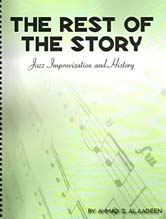 series
of workshops at the University of
Nebraska-Lincoln School of Music.
series
of workshops at the University of
Nebraska-Lincoln School of Music.![Alaadeen [Courtesy Photo]](media/1009alaadeen2.jpg) Alaadeen
continually stresses the importance of
an individual sound, a sound that is
impossible to achieve by acquiring
academic technique alone. The book
offers many tips on how to reach that
unique sound, that personal identity.
Alaadeen
continually stresses the importance of
an individual sound, a sound that is
impossible to achieve by acquiring
academic technique alone. The book
offers many tips on how to reach that
unique sound, that personal identity.
![The first Berman Music Foundation newsletter was published in October 1995 [File Photo]](media/NewsV1N1Oct95.jpg) All
available issues of the BMF
newsletter—65, at last count—are now
online in PDF format. For the first time
since the foundation was formed in the
spring of 1995, website visitors can
peruse its entire documented history.
Artist interviews, features on recording
sessions, concert and CD reviews, travel
stories, original photographs and
commentary of every sort are included,
creating a panoramic view of a whole era
of jazz and other American roots music,
not only in Lincoln and Omaha, but in
Kansas City, Mo., Topeka, Kan., Chicago,
San Francisco, New York City and beyond.
All
available issues of the BMF
newsletter—65, at last count—are now
online in PDF format. For the first time
since the foundation was formed in the
spring of 1995, website visitors can
peruse its entire documented history.
Artist interviews, features on recording
sessions, concert and CD reviews, travel
stories, original photographs and
commentary of every sort are included,
creating a panoramic view of a whole era
of jazz and other American roots music,
not only in Lincoln and Omaha, but in
Kansas City, Mo., Topeka, Kan., Chicago,
San Francisco, New York City and beyond.
![July 2009 edition of the BMF newsletter [File Photo]](media/NewsV14N3Jul09.jpg) Since
its ragged but righteous, four-page
debut in October 1995, the newsletter
has gone through many changes. It
quickly grew to eight, 10 and 12 pages
monthly, primarily as a listing of
upcoming local performances, brief CD
reviews and editorial columns. The
design became more attractive, going
from two columns to three and adding
more original photos, eventually in full
color. Most recently, we adopted a new
BMF logo for the newsletter, designed by
a longtime friend of the foundation,
Lincoln graphic artist Reynold Peterson.
A more generic symbol, it affirms the
BMF mission to protect and promote all
forms of American music. It will soon be
adapted to the website, as well.
Since
its ragged but righteous, four-page
debut in October 1995, the newsletter
has gone through many changes. It
quickly grew to eight, 10 and 12 pages
monthly, primarily as a listing of
upcoming local performances, brief CD
reviews and editorial columns. The
design became more attractive, going
from two columns to three and adding
more original photos, eventually in full
color. Most recently, we adopted a new
BMF logo for the newsletter, designed by
a longtime friend of the foundation,
Lincoln graphic artist Reynold Peterson.
A more generic symbol, it affirms the
BMF mission to protect and promote all
forms of American music. It will soon be
adapted to the website, as well.
![Hanover House B&B in Niagara Fall, N.Y. [Photo by Tom Ineck]](media/1009tomfoolery1.jpg) We
had just two nights in Chicago, with full-day drives before and after,
so our visit there was limited to a few good meals, a walk to the
downtown shopping district, a visit to the Art Institute and a pleasant
stay at the Congress Plaza Hotel on Michigan Avenue, which is a short
stroll from Grant Park and the lake.
We
had just two nights in Chicago, with full-day drives before and after,
so our visit there was limited to a few good meals, a walk to the
downtown shopping district, a visit to the Art Institute and a pleasant
stay at the Congress Plaza Hotel on Michigan Avenue, which is a short
stroll from Grant Park and the lake. ![Niagara Falls at twilight from the observation deck [Photo by Tom Ineck]](media/1009tomfoolery2.jpg) get
to Niagara Falls, N.Y., we learned to take everything she said with a
healthy dose of skepticism. Interstate 90 along Lake Erie would have
gotten us to our destination with less grief, in less time, but we
wouldn’t have seen as much of the Canadian countryside.
get
to Niagara Falls, N.Y., we learned to take everything she said with a
healthy dose of skepticism. Interstate 90 along Lake Erie would have
gotten us to our destination with less grief, in less time, but we
wouldn’t have seen as much of the Canadian countryside. ![A scary view through the glass floor of the CN Tower in Toronto [Photo by Tom Ineck]](media/1009tomfoolery5.jpg) falls
itself. Like most first-time visitors, we purchased the all-in-one
admission, which covers the Maid of the Mist boat ride, the Cave of the
Winds walk under the falls, the Discovery Center and other attractions.
Still, it was the primordial power of nature as we stared transfixed
above American Falls and Bridal Veil Falls that continued to amaze.
falls
itself. Like most first-time visitors, we purchased the all-in-one
admission, which covers the Maid of the Mist boat ride, the Cave of the
Winds walk under the falls, the Discovery Center and other attractions.
Still, it was the primordial power of nature as we stared transfixed
above American Falls and Bridal Veil Falls that continued to amaze. ![The cast of "0% Down, 100% Screwed" [Photo by Tom Ineck]](media/1009tomfoolery6.jpg) exhibition
of the Dead Sea Scrolls had just opened.
exhibition
of the Dead Sea Scrolls had just opened.![Tom and Mary Jane at the Kinzua Bridge [Photo by Greg Page]](media/1009tomfoolery7.jpg) people
with charming Victorian homes, one of which is owned by our friends Greg
and Suzy. Much time was spent simply relaxing over eats, drinks and
conversation, but one of the highlights of our weekend visit was a day
trip to see the remains of the historic Kinzua Bridge, which at the time
of its construction in 1882 was the tallest and longest railway bridge
in the world. In 2003, a tornado collapsed much of the span as it was
being restored. We narrowly missed a stop at the Zippo/Case Museum, a
15,000-square-foot building housing rare Zippo lighters and Case knives.
Maybe next time.
people
with charming Victorian homes, one of which is owned by our friends Greg
and Suzy. Much time was spent simply relaxing over eats, drinks and
conversation, but one of the highlights of our weekend visit was a day
trip to see the remains of the historic Kinzua Bridge, which at the time
of its construction in 1882 was the tallest and longest railway bridge
in the world. In 2003, a tornado collapsed much of the span as it was
being restored. We narrowly missed a stop at the Zippo/Case Museum, a
15,000-square-foot building housing rare Zippo lighters and Case knives.
Maybe next time.![Rock and Roll Hall of Fame and Museum [Photo by Tom Ineck]](media/1009tomfoolery8.jpg) and
Museum. After a brisk walk, I had just 2½ hours to spend at the museum
before closing time. It was even more entertaining and educational than
I had anticipated, containing hundreds of historic instruments, outrageous
stage
costumes, rare photographs and other definitive rock ‘n’ roll
memorabilia. It’s an experience that should be shared with a fellow rock
fan, and I couldn’t help thinking how much fun it would have been with
Butch Berman along. He never made it to the museum, but I know he would
have loved it.
and
Museum. After a brisk walk, I had just 2½ hours to spend at the museum
before closing time. It was even more entertaining and educational than
I had anticipated, containing hundreds of historic instruments, outrageous
stage
costumes, rare photographs and other definitive rock ‘n’ roll
memorabilia. It’s an experience that should be shared with a fellow rock
fan, and I couldn’t help thinking how much fun it would have been with
Butch Berman along. He never made it to the museum, but I know he would
have loved it.
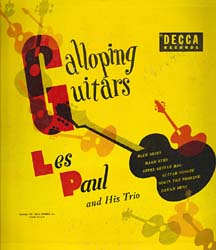 The
closest thing to jazz would be finding a
network feed of Martin Block's “Make
Believe Ballroom.” Songs dominating the
various "hit parades" bore such
innocuous titles (with lyrics to match)
as “Cruising Down the River,” “Bibbidi-Bobbidi-Boo,”
and “Dear Hearts and Gentle People.”
These "hit parades" were loosely
compiled stats from requests to disc
jockeys, band leaders and from plays on
juke boxes. In Omaha, Todd Storz of the
brewery family would not initiate the
nation’s first "top 40" radio format on
KOWH until 1955.
The
closest thing to jazz would be finding a
network feed of Martin Block's “Make
Believe Ballroom.” Songs dominating the
various "hit parades" bore such
innocuous titles (with lyrics to match)
as “Cruising Down the River,” “Bibbidi-Bobbidi-Boo,”
and “Dear Hearts and Gentle People.”
These "hit parades" were loosely
compiled stats from requests to disc
jockeys, band leaders and from plays on
juke boxes. In Omaha, Todd Storz of the
brewery family would not initiate the
nation’s first "top 40" radio format on
KOWH until 1955.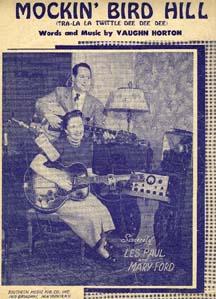 “Lover” and
“Brazil.” We didn't hear much the next
year but by 1950 he had teamed up with
Colleen Summers, aka Mary Ford, and the
hits started coming. A pioneer in
multiple-track recordings, Les'
fantastic guitar runs and Mary's dubbed
harmonizing literally created a sound
like no other. Mary was no slouch on
guitar, either.
“Lover” and
“Brazil.” We didn't hear much the next
year but by 1950 he had teamed up with
Colleen Summers, aka Mary Ford, and the
hits started coming. A pioneer in
multiple-track recordings, Les'
fantastic guitar runs and Mary's dubbed
harmonizing literally created a sound
like no other. Mary was no slouch on
guitar, either. 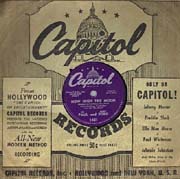 And so
it went, throughout the early
1950s—“Josephine,” “Whispering,” “Tiger
Rag,” “Carioca,” “Just One More Chance,”
“Meet Mr. Callaghan,” “Bye Bye Blues,”
“Sitting On Top Of The World,” “I Really
Don't Want to Know,” “I'm A Fool To
Care” and perhaps the most
memorable of all, “Vaya con Dios.”
Actual recording dates are not known
as they recorded virtually everything at
home.
And so
it went, throughout the early
1950s—“Josephine,” “Whispering,” “Tiger
Rag,” “Carioca,” “Just One More Chance,”
“Meet Mr. Callaghan,” “Bye Bye Blues,”
“Sitting On Top Of The World,” “I Really
Don't Want to Know,” “I'm A Fool To
Care” and perhaps the most
memorable of all, “Vaya con Dios.”
Actual recording dates are not known
as they recorded virtually everything at
home.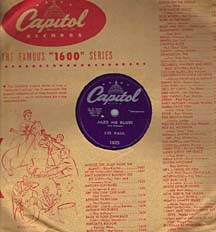 For me,
it wasn't until later years in searching
out jazz that I ran across some of Les'
earlier works, which included backing
such diverse artists as blues singer
Georgia White in the 1930s (over 80
years ago!), Bing Crosby, Dick Haymes,
and performing with numerous jazz
masters, particularly on Norman Granz'
JATP recordings. A serious collector
might want to find the four sides issued
on the Montgomery Ward label from 1936
on 78 rpm under the name of "Rhubarb
Red," which are Les’ first solo records.
(If you've got 'em, let’s talk!) My last
vinyl purchase was the "Chester (Atkins)
& Lester" LP issued in 1976. Though I
lost track of them over the years, Les
(and Mary) were certainly a large part
of my listening and learning experience.
For me,
it wasn't until later years in searching
out jazz that I ran across some of Les'
earlier works, which included backing
such diverse artists as blues singer
Georgia White in the 1930s (over 80
years ago!), Bing Crosby, Dick Haymes,
and performing with numerous jazz
masters, particularly on Norman Granz'
JATP recordings. A serious collector
might want to find the four sides issued
on the Montgomery Ward label from 1936
on 78 rpm under the name of "Rhubarb
Red," which are Les’ first solo records.
(If you've got 'em, let’s talk!) My last
vinyl purchase was the "Chester (Atkins)
& Lester" LP issued in 1976. Though I
lost track of them over the years, Les
(and Mary) were certainly a large part
of my listening and learning experience.